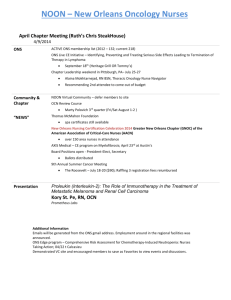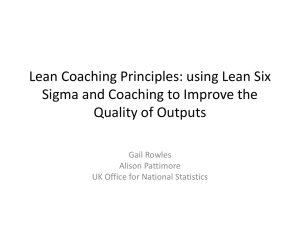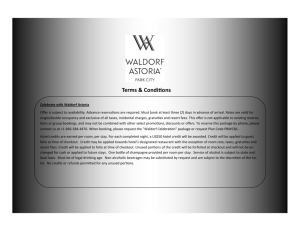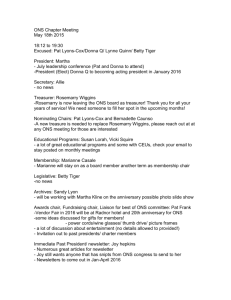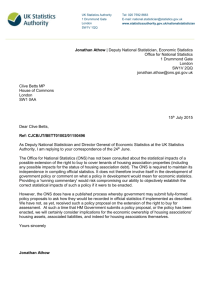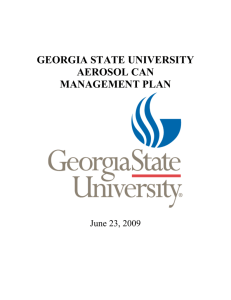EXTRA!! Tis the Season To be Fire Safe
advertisement
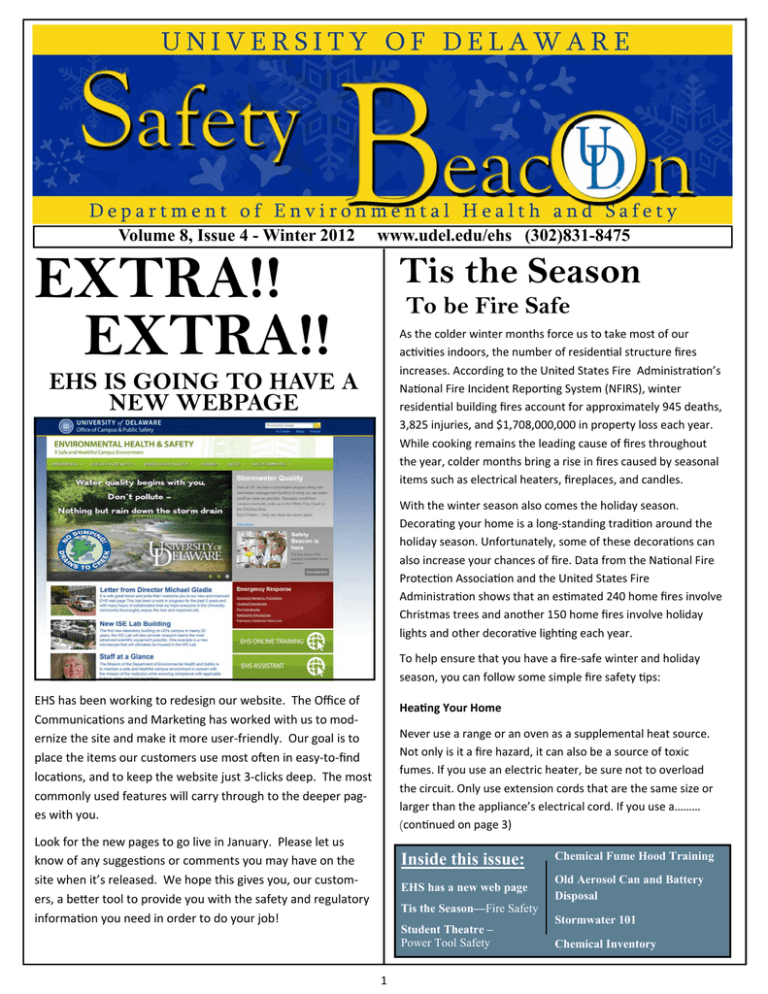
Volume 8, Issue 4 - Winter 2012 www.udel.edu/ehs (302)831-8475 EXTRA!! EXTRA!! Tis the Season To be Fire Safe As the colder winter months force us to take most of our ac vi es indoors, the number of residen al structure fires increases. According to the United States Fire Administra on’s Na onal Fire Incident Repor ng System (NFIRS), winter residen al building fires account for approximately 945 deaths, 3,825 injuries, and $1,708,000,000 in property loss each year. While cooking remains the leading cause of fires throughout the year, colder months bring a rise in fires caused by seasonal items such as electrical heaters, fireplaces, and candles. EHS IS GOING TO HAVE A NEW WEBPAGE With the winter season also comes the holiday season. Decora ng your home is a long-standing tradi on around the holiday season. Unfortunately, some of these decora ons can also increase your chances of fire. Data from the Na onal Fire Protec on Associa on and the United States Fire Administra on shows that an es mated 240 home fires involve Christmas trees and another 150 home fires involve holiday lights and other decora ve ligh ng each year. To help ensure that you have a fire-safe winter and holiday season, you can follow some simple fire safety ps: EHS has been working to redesign our website. The Office of Communica ons and Marke ng has worked with us to modernize the site and make it more user-friendly. Our goal is to place the items our customers use most o en in easy-to-find loca ons, and to keep the website just 3-clicks deep. The most commonly used features will carry through to the deeper pages with you. HeaƟng Your Home Never use a range or an oven as a supplemental heat source. Not only is it a fire hazard, it can also be a source of toxic fumes. If you use an electric heater, be sure not to overload the circuit. Only use extension cords that are the same size or larger than the appliance’s electrical cord. If you use a……… (con nued on page 3) Look for the new pages to go live in January. Please let us know of any sugges ons or comments you may have on the site when it’s released. We hope this gives you, our customers, a be er tool to provide you with the safety and regulatory informa on you need in order to do your job! Inside this issue: Chemical Fume Hood Training EHS has a new web page Old Aerosol Can and Battery Disposal Tis the Season—Fire Safety Student Theatre – Power Tool Safety 1 Stormwater 101 Chemical Inventory Safety Beacon Department of Environmental Health and Safety - Volume 8, Issue 4 - Winter 2012 Student Theatre Groups Receive Hand and Portable Power Tool Safety Training For the second year in a row, students from the E-52 and HTAC theater groups rose early on a Saturday morning to a end a three hour program addressing safe use of hand and portable power tools. Over 80 students involved in the construc on of sets and props par cipated in the program on October 6, 2012. The training was presented by Keith Davis, supervisor of the Professional Theatre Training Program shop. The session covered topics such as choosing the correct tool, which personal protec ve equipment to wear, how to select the right size extension cord, and safe opera on of powered tools. Students actually used a powered chop saw to cut a piece of wood! To encourage proper use of personal protec ve equipment, DEHS supplied each student with a pair of safety glasses and a pair of ear plugs for noise a enua on. The DEHS applauds the students’ willingness to learn the safe use of tools and is indebted to Keith for giving up his Saturday morning and sharing his exper se. This program is supported by the Student Organiza ons Department, the Risk Management Group and the Department of Environmental Health and Safety. Chemical Fume Hood Training Reminder Laboratory chemical fume hoods and ven la on equipment are designed for the protec on of personnel by preven ng contaminants such as vapors, dust, mist, and fumes from being released into the laboratory and building environment. EHS offers a one-hour Laboratory Ven la on Safety course which is recommended for all individuals who u lize chemical fume hoods or other laboratory ven la on units in a laboratory se ng. The Laboratory Ven la on Safety Training covers the key concepts to work safely in a chemical fume hood and with specialized laboratory exhaust ven la on. Remember, safety equipment is there to protect you, but it only works if you use it correctly! 2 Safety Beacon Department of Environmental Health and Safety - Volume 8, Issue 4—Winter 2012 Tis the season — To be Fire Safe (con nued from page 1) fireplace do not use flammable liquids to start or accelerate the fire. Keep a glass or metal screen in front of the fireplace opening to prevent embers or sparks from jumping out. Also keep flammable materials away from the fireplace and mantel; a spark from the fireplace can easily ignite these materials. Make sure that your fireplace/fire is out before you go to sleep and NEVER close your damper with hot ashes in the fireplace. Finally, have your chimney inspected annually and cleaned if necessary. Candles Make sure that candles are in stable holders and keep them where they cannot p over easily. Try to keep them at least 12 inches from anything that can burn. Consider using ba ery-operated flameless candles, which can look and smell like real candles. NEVER leave a lit candle una ended, and NEVER put lit candles on a Christmas tree. Christmas Trees Keep your live Christmas tree watered at all mes and try not to leave it up for longer than two weeks. Do not place your live OR ar ficial tree near a heat source. Also be careful not to block exits with your tree. Holiday Lights Be sure to inspect your holiday lights yearly for any frayed wires, broken or cracked sockets, excessive kinking or excessive wear before you put them up. Only use ligh ng listed by an approved tes ng laboratory. Do not link more than three light strands unless the direc ons indicate that it is safe to do so. Connect strings of lights to an extension cord before plugging the cord into the outlet. Following these simple ps can keep you, your family, and your guests safe. As in every season, be sure to have working smoke alarms installed on every level of your home. Test them monthly and replace the ba eries twice a year (and when needed). Know when and how to call for help, and remember to discuss and prac ce your home escape plan with your loved ones. Wishing you and yours a happy, healthy, and fire-safe winter and holiday season! How Do I Properly Dispose of Those Old Aerosol Cans and Batteries? Many of us don’t think too much about the common household chemical wastes we produce on a daily basis. Here are some ps on how to properly dispose of them: From hair spray to household cleaners, bug repellants to paint, many of our most commonly used products come in aerosol cans. Because they are so common, however, we may think that it’s okay to throw these cans in the trash once they’re empty. Or some people may toss them into a recycling bin thinking that they’re being environmentally conscious. The truth is aerosol cans must be disposed of as chemical waste. All aerosol cans are pressurized and contain a propellant which is flammable. Depending on what the product is, there may be even more hazards present. EPA regula ons state that even if the cans are empty, they must be punctured and drained of their contents before they can be deemed safe for recycling. For safety reasons, however, this is something we don’t recommend you try yourself. So what should you do with them? (con nued on page 4) 3 Safety Beacon Department of Environmental Health and Safety - Volume 8, Issue 4—Winter 2012 How to Properly Dispose of Those Old Aerosol Cans and Ba eries (con nued from page 3) Ba eries are great when you need a portable, convenient power source. Whether they’re star ng your car in the morning, or keeping your flashlight lit during a power outage, we use many different types of ba eries to power our everyday lives. But what happens when they run out of juice? Many of us may think that it’s okay to throw them in the trash, but that’s not the case. Ba eries contain heavy metals such as mercury, lead, cadmium, and nickel, which can contaminate the environment when ba eries are improperly disposed. But how do you know which type of ba ery you have? Or what if you don’t want to want to lug that old car ba ery to Pep Boys for disposal? There are several op ons for disposing of empty aerosol cans and old ba eries. To dispose of empty aerosol cans around your house, the Delaware Solid Waste Authority sponsors special collec on events several mes each year at different loca ons around the state. Similar programs are offered in neighboring states. Used household ba eries can be disposed in yellow recycling bins at your local recycling drop-off center. What about aerosol cans and ba eries generated at the University? That’s where UD’s EHS Department comes in! If you have any aerosol cans (full or empty) or dead ba eries (any type) that you’d like to dispose of, you can simply go to our website at www.udel.edu/ehs or call us at x8475, schedule a chemical waste pick-up, and we’ll come to you! It’s easy, it’s safe, and it’s good for the environment! Delaware Solid Waste Authority Household Waste CollecƟon Dates and LocaƟons hƩp://www.dswa.com/HHWschedule_print.asp Stormwater 101 In a natural se ng, rain and mel ng snow soaks through the ground surface and seeps down through subsurface layers of soil and rock to replenish the groundwater supply, which is the main source of drinking water for many people. Impervious surface areas such as roads, parking lots and building roo ops reduce the amount of land available to absorb rain and snowmelt, causing a reduc on in the amount of water available to recharge groundwater resources and feed surface streams. Low groundwater levels may cause wells to run dry and reduce stream flow during periods of dry weather. In the past decade, droughts have increased in frequency and severity. Bio reten on area near the Bob Carpenter Center While drought is typically associated with lack of rainfall, its effects are compounded when the groundwater supply is already low. In order to meet water demands of growing popula ons, water u li es may need to resort to very expensive alterna ves to ground water supply. Drinking water in the Newark area comes from a combina on of groundwater and water from the White Clay Creek. Local governments have the most influence on groundwater supply through their authority to regulate land use. A stormwater management strategy that priori zes infiltra ng runoff into the ground to recharge the groundwater supply will help alleviate water supply shortages, both above and below the surface. The University of Delaware has been construc ng new buildings and has created more impervious surface. The good news is that the University and the City of Newark have established stormwater management areas on campus so water can infiltrate into the ground to recharge our groundwater reserves. (con nued on page 5) Bio reten on area near the East Campus U lity Plant 4 Safety Beacon Department of Environmental Health and Safety - Volume 8, Issue 4—Winter 2012 Stormwater 101 (con nued from page 4) Areas on campus that look like landscaping may actually be rain gardens, bio-filtra on areas, or wetlands. These areas hold the stormwater runoff for a period of me and allow the rain water to slowly infiltrate the soil to reach the groundwater layers. The strategy is supplan ng the tradi onal method of directly piping stormwater underground to the nearest stream. This method is no longer preferred as it causes high flow stream condi ons which cause stream bank erosion. This in turn, causes problems for fish and underwater vegeta on, affec ng the health of the stream. So, when you walk around campus enjoying the beauty of our UD landscaping, think about the ways in which we are managing our stormwater to reduce runoff, recharge the groundwater, and create cleaner water for the flora and fauna in the stream as well as for ourselves! Bio reten on area near the Bob Carpenter Center Addi on It’s Workplace Chemical Inventory Time Federal and state regula ons require an annual inventory of hazardous chemicals stored on University property. This informa on is used by local agencies to plan for emergency responses. The Department of Environmental Health and Safety is reques ng the assistance of the University’s safety commi ees with this inventory. Safety commi ee chairs will be receiving survey forms this month; the Department is asking the commi ees to review their chemical inventories and respond by February 1, 2013. This informa on will be compiled into the University database which must be submi ed to the State of Delaware. Any ques ons about the Workplace Chemical Inventory can be addressed to Bill Harris at 831-8274. 5

